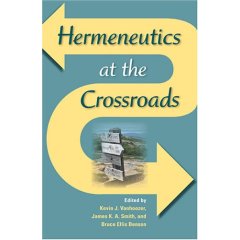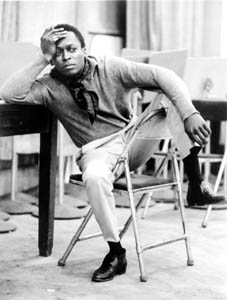
Nicholas Wolterstorff
“Resuscitating the Author”
Hermeneutics at the Crossroads
Chapter 2, Pages 35-50
2006
Resuscitating the author, while rejecting “authorial intent”
Wolterstorff begins by distancing himself from the text and drawing closer to the author of the text:
My claim will be that...most of the time all of us practice one, that is basic to almost all other kinds of interpretation, and that this kind of interpretation, rather than consisting at bottom of things done to an artifact, consists of an engagement with a person, which is mediated by the artifact. (36)
This move by Wolterstorff sets the tone for the essay. He is critical of the move by Gadamer and those subsequent to Gadamer who moved away from the author. He speaks of this as hermeneutical “orthodoxy,” which Wolterstorff notes was reactionary:
The orthodoxy in question arose as a reaction to the view that the interpretation of texts is at bottom an engagement with the person who authored the text, in that way, my view is a recovery of what preceded the formation of orthodoxy. But I join with orthodoxy in rejecting what the pre-orthodox said it was that we try to discover and understand when we interpret; that is to say, I hold that our mode of engagement with the author, when we interpret, is different from the pre-orthodox thought it was. They held that its goal is to get at the authorizer’s intention; I hold that its goal is to get at what the authorizer said. Those two, I argue, are not to be identified with each other. (36-37)Wolterstorff’s first move – to recover the author (“an engagement with a person”) – seems clear enough, particularly throughout the essay as he criticizes the hermeneutics that has moved away from the author and into the text. But it is much more difficult to discern what Wolterstorff means when differentiates “the authorizer’s intentions” and “what the authorizer said.” Wolterstorff criticizes those who seek “the authorizer’s intentions.” But if Wolterstorff moves away from “intentions,” isn’t he moving away from the author, at least in some way? From Wolterstorff’s essay it is difficult to see how he can criticize a focus on authorial intent and at the same time can speak of interpretation as “an engagement with a person.” We will see, later, how Wolterstorff brings this together.
Criticism of “hermeneutic orthodoxy”Wolterstorff then criticizes those who move away from the author and towards a focus upon the text, itself. He describes the move away from the author and towards the text as “hermeneutic orthodoxy”:
What is it, according to the hermeneutic orthodoxy of the latter half of the twentieth century, that the interpreter should aim at?…interpretation deals with texts rather than persons…the meaning, or the sense, of the text…Textual-sense interpretation, as I call it, has been the orthodoxy of pre-deconstructionist twentieth-century interpretation theory…(italics belong to the author) (38)
That which one understands, when one understands a text, is not “a repetition of something past” but “a present meaning” shared between author and interpreter. It is, if you will, an ever-present meaning. (39)
It is not really a relationship between persons, between the reader and the author (who is, perhaps quite unknown), but about sharing in what the text shares with us. (40)
For Ricoeur, as for Gadamer, the central goal of interpretation is to identify and grasp the meanings of the sentences of the text…we can just as well say that the goal of interpretation is to identify and grasp the propositional content of the illocutionary act. (41)Wolterstorff then levels his major charge against those who detach the text from the author:
If we insist on leaving authors out of the picture, and taking the text in itself as the object of interpretation, then I think textual-sense interpretation cannot but give way to performance interpretation; there is no way to stop the slide. (46)
Wolterstorff explains that “performance interpretation” is what happens when “one imagines what some French writer of the early twentieth century might have meant had he produced the text of Don Quixote…what some writer of Kantian persuasion might have meant had he produced the text of the Prologue of John’s Gospel…” (46)But this is a point that I am not entirely clear on. How is it that a move to the text, as Wolterstorff has described of Gadamer, can give way to this sort-of radicalization. Wolterstorff clearly seems to be presenting some form of the “slippery slope” argument, but he is not as clear as to how a focus on the text takes us down this slippery slope.
(The thing about slippery slope arguments is that one must clearly demonstrate the how a position takes one down the slope, and cannot merely assert that such is the case. After all, if we all began to use the slippery slope argument without substantiation this would take us down a slippery slope, indeed!)
The point is simply that I did not find Wolterstorff convincing that the hermeneutic of Gadamer/Ricoeur would take us into the so-called “performance interpretation.”
Wolterstorff’s alternative: “Authorial Discourse Interpretation”Wolterstorff is now ready to focus on his alternative to “authorial intent” and “hermeneutic orthodoxy”:
My contention is that none of us practices performance interpretation most of the time…46
The mode of interpretation that most of us practice most of the time is that which Derrida is calling for on the part of those who interpret his writings. I call it authorial discourse interpretation. In authorial discourse interpretation one seeks to identify and grasp the illocutionary acts that the authorizer of the text performed by inscribing, or in some other way authorizing, the words that one is interpreting. (italics belong to the author) (47)So, Wolterstorff’s alternative is “authorial discourse interpretation.” This is intimately tied to the illocutionary acts. What are these “illocutionary acts”? Wolterstorff does not really explain in this essay, and there is a bit of ambiguity as to the precise nature of an illocutionary act. However, it would have aided Wolterstorff’s essay immensely to define how he is using the term illocutionary act, since to my knowledge there is still some ambiguity attached to this term and it has been used with slightly different nuance in varying contexts.
By outlining his
authorial discourse interpretation Wolterstorff wants to distance himself from “hermeneutic orthodoxy” while at the same time avoiding the “pre-orthodoxy” mistake of focusing strictly on authorial intent.
But despite his distance from authorial intent, Wolterstorff does make one qualification on authorial intent:
These observations lead me to attach an explanatory qualification to my main thesis, however. Sometimes, when it is clear to us that what the author said is not what he intended to say, our interest is more in what he intended to say than on what he did say. (48-49)
In his conclusion, Wolterstorff takes note of what he believes are ethical implications of interpretation:
My account of interpretation has important ethical implications. If the interpretation that most of us perform most of the time consists of engaging a person rather than just doing something to an artifact, then the issue arises of whether we have engaged that person justly, charitably, honorably, and the like. (49)There do certainly seem to be ethical implications to Wolterstorff’s theory of interpretation, but this seems to be the case only if we tie the text so close to the author that a violation of the text represents a violation of the author of the text. But surely this cannot always be the case. A person who, unwittingly misunderstands and thus misrepresents my writing does not seem to be violating any higher order moral value. And perhaps it is for this reason that Wolterstorff speaks of acting “charitably” or “honorably.” Rather than having an ethical obligation to interpret correctly, it would seem the ethical obligation is to simply do one’s best to interpret. But does the author have a similar obligation in communicating? What if an author has not done his or her best to communicate? In my opinion it may get complicated to start to assign ethical obligations to readers and authors. This is not a reason to shy away from it, however, because most of the time the assignment of ethical obligations gets complicated!
Engaging Wolterstorff: What is the issue? The author and the text.
What emerges from this insightful essay of Wolterstorff’s are questions of interpretation. More specifically, the questions center on
how closely the text is tied to the author. On the one hand, it seems clear that once the text is written it is detached, in some way, from the author. The author can no longer control it. The author will even be physically detached from his or her text. (Especially if said author is deceased.) The text may even undergo revisions and translations that alter it in insubstantial ways. Furthermore, the author may not even completely understand the text after having written it. Imagine authoring a text at the age of 18 and then revisiting the text 50 years later. Would the author recognize his or her work, anymore? Would they be able to “transport” themselves back 50 years into their mind-set and be able to discern their “intentions.” In all likelihood they would not!
Furthermore, imagine a scenario in which an author pens a powerful and insightful text and does so with great thought and care. Because it is such an original and penetrating text it is studied for generations on end by the brilliant scholars of each age. Is it not conceivable in this scenario that those who study it in later generations might have a better understanding of the text than the author? Perhaps those of later generations would be able to detect nuances and subtleties that the author missed? Or perhaps they would better understand the historical situation of the text even better than the author?
But we can even move this scenario into everyday life. If a child writes a summary of the days events in their diary would it really be so inconceivable that an insightful parent might not better understand the text than the child, themselves? Is it inconceivable that someone more familiar with the issues I am raising in this text might better understand it than myself, its author?
For all of the above reasons it seems as though the text exists as its own entity. Readers can take ownership of it and, to some degree, it becomes their playground. However, does this mean that we can completely detach the text from the author? I think not. As I review my own text above I note that in one place I state in parentheses that “Italics belong to the author.” Why do we do this if not for the fact that at some level we recognize that the text is a creation, and that every creation has a creator.
God created. He created his world. But his world is now detached. Perhaps in some way this mirrors the fact that every text belongs to the creative ingenuity of the author and yet the author must relinquish the text. The text becomes its own, and yet it always remains a created entity, a creation of the author.
Citation:Nicholas Wolterstorff, “Resuscitating the Author” in Hermeneutics at the Crossroads, ed. Kevin J. Vanhoozer, James K.A. Smith, and Bruce Ellis Benson (Bloomington and Indianapolis: Indiana University Press, 2006).Other essays reviewed in Hermeneutics at the Crossroads:Bruce Ellis Benson "The Improvisation of Hermeneutics"James K.A. Smith "Limited Inc/arnation"Kevin Vanhoozer "Discourse on Matter"Nicholas Wolterstorff "Resuscitating the Author"










